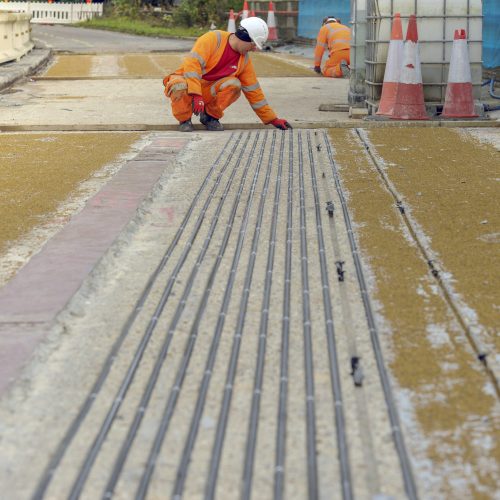 Traditionally the M25 road network, originally built in the 1970s has been stabilised using steel plates. However, during strengthening works on the east bridge of the Swanley Interchange, the Octavius team recognised that this approach wouldn’t be a suitable long term stabilisation solution due to the road’s significant deterioration and to ensure its future resilience to withstand harsh conditions and weather.
Traditionally the M25 road network, originally built in the 1970s has been stabilised using steel plates. However, during strengthening works on the east bridge of the Swanley Interchange, the Octavius team recognised that this approach wouldn’t be a suitable long term stabilisation solution due to the road’s significant deterioration and to ensure its future resilience to withstand harsh conditions and weather.
Octavius devised a bespoke innovative engineering solution which involved sequentially removing the existing steel plates and replacing them with carbon fibre-reinforced polymer rods (CFRP). The rods are lighter weight, less likely to crack and able to withstand the harshest environmental conditions in comparison to traditional steel plates. It also remains resistant to corrosion and decay, ensuring that any structural components protected with carbon fibre will maintain their operational efficiency over time.
The Octavius team have successfully completed renewal works on the east and west bridge, in total installing 364 CFRP rods. The installation of rods on the Swanley Interchange was a first for both the M25 and the UK. This project sets a new standard, paving the way for the widespread adoption of CFRP rods in similar projects across the road network.
This key project had been a priority on National Highways’ improvements agenda. Through our team’s solution-driven expertise, the network has been made safer, more resilient for future road users and increases life span of the bridge.
This innovative project was recognised at the 2024 Highways Awards, where Octavius and its partners received a Highly Commended award in the Innovation category, celebrating their ground-breaking work and contribution to infrastructure resilience.
A more sustainable solution
The use of CFRP significantly reduce CO₂ emissions, by replacing traditional materials we can have saved 8,100 tonnes of CO₂ emissions, contributing to a lower carbon footprint and supporting sustainable objectives of creating a cleaner and greener infrastructure.
Time saving
After removing the original surfacing, waterproofing, and grout layers, grooves were cut into the existing deck slabs to accommodate the installation of the rods. To help save time and ensure the work was completed to programme the team developed a bespoke bracket to enable saw-cutting 12-meter tracks.
This innovative bracket features a retractable extended arm, allowing multiple grooves to be cut in one anchoring setup. This streamlined process eliminates the need to reposition the bracket after each groove, resulting in a timesaving of approximately four hours per shift. The implementation of several efficiencies allowed the project to complete one week ahead of schedule.
If you want to learn more about how Octavius improve and maintain the M25 Network contact hello@octavius.co.uk
Access Our Growing Resource Centre
Stay informed with regularly updated resources and insights designed for professionals driving accessible rail projects. Access key reports and practical guidance to support your AfA projects. With insights into proven practices, compliance requirements and in depth summaries from InnovateUK and the House of Commons, the AfA resource centre is your starting point for delivering inclusive rail infrastructure.
Our collection is continuously growing—sign up now to stay informed as new resources are added.

